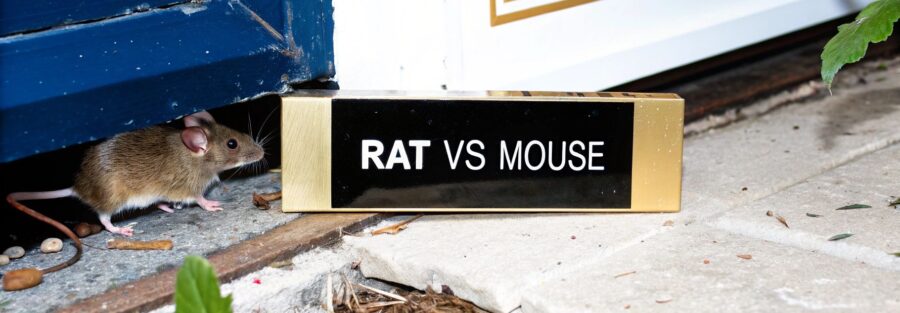So, you think you have a rodent problem, but are you dealing with rats or mice? Getting it right is the first, and most important, step in taking back your home.
At a glance, the main difference comes down to size and confidence. Rats are much larger and naturally cautious, whereas mice are small, slim, and famously inquisitive. This basic behavioural split changes everything—from the type of damage you’ll find to the best way to get rid of them.
A Guide to UK Rat and Mouse Identification
Figuring out which rodent has moved in can be tricky, but you’re not alone. This guide will walk you through a clear, side-by-side comparison to help you identify your unwanted guests with certainty.
One of the most common mistakes is confusing a young rat for a fully-grown mouse. While they might look a similar size, their proportions are a dead giveaway. A juvenile rat will have a big head and large feet that look out of place on its small body, but a mouse’s features are always neat and proportional.
Getting this right from the start is crucial for picking a pest control strategy that actually works.
Quick Answer At-a-Glance Comparison
To make identification even easier, here’s a quick reference table. It summarises the key physical and behavioural differences between the Brown Rat and the House Mouse—the two rodent pests we see most often in UK properties.
| Feature | Brown Rat (Rattus norvegicus) | House Mouse (Mus musculus) |
|---|---|---|
| Adult Size (Body) | 18-25 cm (7-10 inches) | 6-9 cm (3-4 inches) |
| Weight | 150-500g | 12-30g |
| Ears | Small, thick, covered in fine hairs | Large and prominent relative to head |
| Snout | Blunt and rounded | Pointed, triangular shape |
| Tail | Shorter than body, thick and hairless | As long as or longer than body, thin |
| Droppings | 12-18mm, blunt ends (like a capsule) | 3-6mm, pointed ends (like rice) |
| Behaviour | Cautious, avoids new objects (Neophobic) | Curious, readily investigates new things |
Remember, these details—especially the droppings and behaviour—are often the clearest signs you'll find. A cautious rat will ignore a new trap for days, while a curious mouse might investigate it within minutes.
Comparing Physical Differences for Accurate ID
While size is the most obvious place to start, it’s the subtle physical traits that really give the game away when telling rats and mice apart. A proper identification means looking beyond that first glance and examining the details, from the shape of the snout to the length of the tail. Getting this right is the foundation of any effective pest control strategy.
This visual guide breaks down the key differences between a rat and a mouse, side-by-side.

As the image shows, the proportions of features like ears and tails are often far more reliable clues than body size alone, especially when you might be dealing with a juvenile.
Head and Facial Features
A close look at the head reveals some big giveaways. A brown rat has a blunt, thick snout, giving its face a more rounded and powerful look. Its ears are small, thick, and covered in fine hairs, sitting close to its head.
In contrast, a house mouse has a small, pointed, triangular-shaped nose. Its ears are a standout feature—they’re large, almost paper-thin, and look oversized for its head, giving it a completely different profile.
Body, Tail, and Feet Proportions
The most common identification mistake? Confusing a young rat with an adult mouse. While they can be similar in size, their proportions are a dead giveaway. A young rat’s head and feet will look disproportionately large for its body, a bit like a puppy that hasn’t grown into its paws yet.
An adult mouse, on the other hand, is always well-proportioned. Its head, body, and feet are all in balance.
Key Takeaway: If the rodent's head and feet look too big for its body, you are almost certainly looking at a juvenile rat, not a mouse. This distinction is vital, as a young rat signals the potential for a much larger infestation down the line.
Their tails offer another clear point of difference:
- Rat Tail: Thick, scaly, and noticeably shorter than its body.
- Mouse Tail: Thin, hairy, and usually as long as—or even longer than—its body.
A Key Clue: Droppings
Often, the most definitive proof you'll find is what the rodents leave behind. The size and shape of droppings are one of the most reliable ways to identify your unwanted guest.
- Rat Droppings: These are large, measuring between 12-18mm. A brown rat’s droppings are typically capsule-shaped with blunt, rounded ends.
- Mouse Droppings: These are much smaller, usually just 3-6mm long. They are thin, pointed at both ends, and often look like dark grains of rice.
In the UK, the size difference is stark. The common brown rat (Rattus norvegicus) can weigh up to 500 grams, whereas a house mouse (Mus musculus) weighs only about 12-30 grams. With an estimated 1.3 rats per person in the UK, understanding these physical signs is crucial for managing a widespread issue.
Of course, knowing what attracts these pests is the next step in prevention. You can learn more about what attracts rats to your house in our detailed guide.
Behavioural Traits That Define Their Presence
To get the upper hand on a rodent problem, you need to start thinking like one. The psychological differences between rats and mice are huge, and they dictate exactly how these pests will interact with your home or business. Understanding their behaviour is the only way to predict their movements, find their nests, and choose a control strategy that actually works.
It all boils down to their reaction to new things. Rats are instinctively neophobic, which is a fancy way of saying they are deeply suspicious of anything new in their environment. This is a survival instinct, and it’s what makes them so tricky to trap. They’ll often give a brand-new trap or bait station a wide berth for days, sometimes even weeks, until they finally decide it’s safe to approach.
Mice, on the other hand, couldn’t be more different. They’re incredibly inquisitive and will eagerly check out new objects in their territory. It’s this natural curiosity that makes them much easier to trap; they’ll often investigate a new trap within just a few hours of it being placed.

This fundamental difference—cautious versus curious—is probably the single most important thing to know when you're deciding on a removal plan.
Nesting and Territory Habits
The way rats and mice set up house also varies quite a bit. Rats, especially the Brown Rat we see all over the UK, are expert burrowers. They tend to make their nests in the lower levels of a building, think basements, crawl spaces, or inside wall cavities close to the ground. If they’re outside, they’ll dig extensive burrow systems in the soil, under your decking, or inside a warm compost heap.
Mice are fantastic climbers and prefer to nest somewhere secluded and out of the way, often much higher up. You’re far more likely to find a mouse nest in the loft, tucked away behind an appliance, or hidden inside a cluttered cupboard. Their nests are small and messy, usually made from shredded paper, fabric, or insulation they've found nearby.
Situational Example: If you’re hearing scratching sounds from the loft or in the ceiling, it’s a good bet you’re dealing with mice. Noises coming from under the floorboards or from walls on the ground floor point more towards rats.
Daily Movement and Feeding Patterns
Rodents are creatures of habit, and their daily routines offer big clues about who you’re dealing with. Rats stick to familiar routes, using the same "runways" over and over again. They often travel right up against walls or other surfaces, using their whiskers to navigate, and leave behind greasy smudge marks from their fur.
Mice are more erratic. While they also use walls for guidance, their territory is much smaller, and they tend to roam more freely within it. A mouse might only travel 3 to 9 metres from its nest to find a meal.
Their food preferences are also completely different, which is critical when you’re choosing bait:
- Rats Prefer: Foods high in protein. They’re drawn to things like meat, fish, pet food, and anything greasy.
- Mice Prefer: Cereals and seeds. They’ll go for grains, nuts, and sweet things like chocolate or peanut butter.
This is exactly why a bait that works a treat for mice might be totally ignored by rats. Knowing the difference between rats and mice in their day-to-day habits isn't just trivia; it's practical intelligence you need to outsmart them.
Understanding Health Risks and Property Damage
While you don't want either rodent in your home, the threats they bring are quite different. The real contrast comes down to the scale and type of damage they inflict. Rats are a major threat because of their size and strength, while mice are dangerous because of the widespread, subtle contamination they leave behind.
Rats are infamous for the serious structural damage they can cause. Their teeth are incredibly strong and never stop growing, which forces them to constantly gnaw on hard materials to file them down. This instinct can have disastrous results for your property.
The Destructive Power of Rats
A rat infestation often leads to severe and costly repairs. Their powerful jaws can chew through a surprising range of materials, leading to some very specific dangers:
- Electrical Fires: Gnawed electrical wiring is a leading cause of house fires. Rats love to strip the plastic insulation from cables, leaving live wires exposed inside wall cavities and lofts.
- Flooding and Water Damage: They’ve been known to chew through plastic and even soft metal pipes. A small leak can quickly lead to extensive water damage and dangerous mould growth.
- Structural Weakening: Over time, rats can weaken wooden joists, supports, and other structural timbers with their relentless gnawing.
Beyond the damage to your property, rats are carriers of some nasty diseases. In the UK, they are most notoriously linked with Weil's disease (Leptospirosis), a serious bacterial infection spread through their urine, which can easily contaminate water sources or soil.
Key Insight: The primary danger from rats is often direct and destructive. A single rat can cause thousands of pounds in damage to wiring or plumbing, creating immediate safety hazards that are expensive to fix.
The Contamination Risk from Mice
Mice are much smaller, so they don’t cause the same dramatic structural damage. Their threat is more insidious and revolves almost entirely around contamination. A single female mouse can produce 50-80 droppings per day, and they urinate constantly as they move around their territory.
This prolific output means they can contaminate a huge area in a very short time. Their droppings and urine can spread pathogens like Salmonella and are a common trigger for allergies or asthma. Because mice are naturally curious and roam widely, they can easily contaminate kitchen worktops, food cupboards, and utensils without you even knowing.
Ultimately, knowing the different risks helps you understand how urgent the problem is and what kind of response you need. The potential costs of a rat infestation, for instance, are often higher because of the immediate structural threats they pose. If you suspect a problem, learning more about the pest control cost for rats can give you a clear idea of what to expect for professional removal and proofing, ensuring your property is secured against these destructive pests.
A Look Back: Rodents Throughout British History
To really get a handle on the rats and mice we see today, it helps to understand their long and often dramatic history with us here in Britain. The story of UK rodents is essentially a tale of two rival species, a series of invasions, and major historical events that shaped the populations we now have to deal with.
For centuries, the main character in this story was the black rat (Rattus rattus), often called the ship rat. This agile climber first hitched a ride with Roman traders and quickly made itself at home across the country. It was the dominant rat species for ages, living side-by-side with people in old-style, thatch-roofed buildings.
A New Rival Arrives
Everything was turned on its head when the brown rat (Rattus norvegicus) showed up. Bigger, more aggressive, and a far better burrower and swimmer, the brown rat started appearing in Britain around the early 18th century. It didn't take long for it to completely outmuscle the black rat for food and shelter.
This wasn't just a small change; it was a total takeover. The brown rat was perfectly suited to the new sewer systems and brick buildings of the industrial era, and it pushed the black rat to the very edge of extinction in the UK. Today, the black rat is incredibly rare, found only in a handful of isolated port areas.
A Tale of Two Rats: The brown rat's complete dominance over the black rat is a textbook example of what ecologists call 'competitive exclusion'. The brown rat's bigger size, aggressive nature, and knack for adapting to our changing towns and cities allowed it to completely rewrite Britain's rodent landscape.
A Lasting Impact on Pest Control
The history of these species has had a massive impact. The black rat is famously tied to one of Britain's darkest periods: the Great Plague of 1665. The fleas these rats carried were the vectors for the disease that wiped out a huge portion of London's population. While the black rat was the carrier during the plague, the later arrival of the much larger brown rat eventually displaced them almost entirely. You can read more about these historical rodent dynamics in the UK.
This history lesson isn't just for interest; it explains exactly why the brown rat is the number one rat we face in modern pest control. Their burrowing habits and incredible adaptability are a direct legacy of this centuries-long takeover.
Choosing the Right Pest Control Strategy
Once you've figured out which rodent has moved in, you can choose a control method that works with their behaviour, not against it. A one-size-fits-all approach just doesn't cut it here; the core difference between rats and mice—cautious versus curious—demands entirely different game plans. Getting it wrong is more than a waste of time; it can actually make your infestation worse.
The trick is to use their own psychology against them. A mouse's nosy nature makes it an easy target for traps placed right in its path. On the other hand, a rat's neophobia (fear of new things) means it will deliberately avoid anything unfamiliar for days. This calls for a much more patient and cunning approach to get past its built-in suspicion.

Tailoring Your Trapping and Baiting
For a mouse problem, the best bet is to set out multiple small traps. Place them right up against the walls where you know they travel, spacing them about two to three feet apart. Because they’re so inquisitive, mice will often investigate new objects within hours. A pea-sized smear of peanut butter or chocolate is usually all the bait you need.
Rats, however, need a completely different strategy. You'll want fewer, but much more powerful, traps designed for their size. Crucially, you need to place these traps unset in their regular runways for a few days first. This lets the wary rats get comfortable with them. Only when they’ve accepted the traps as part of the scenery should you bait them with something high in protein, like bacon or dried meat, and set them.
Situational Tip: If you notice gnaw marks on a new trap but it hasn't been sprung, you're almost certainly dealing with rats. They're cautiously testing the object. Don't move it—just give them more time to get used to it before you set it.
Exclusion Is the Best Defence
Traps and baits are reactive measures. The single most effective, long-term solution is exclusion. It’s simple: seal up every possible entry point to stop rodents from getting in at all. This is the cornerstone of any proper pest control plan.
- For Mice: Seal any crack or hole bigger than 6mm—that's about the width of a pen. Pay special attention to gaps around pipes and under doors.
- For Rats: Block any opening larger than 2cm, or roughly the size of a 10p coin. Check your air bricks, any damaged drains, and look for gaps in the building's foundation.
Use tough, durable materials like wire wool, cement, and metal plates to make sure the fix is permanent. For a deeper dive into securing your property, check out our guide on how to prevent rats. While a bit of DIY can handle minor issues, a widespread or stubborn infestation often needs a professional eye to guarantee every single entry point is found and sealed for good.
Your Questions Answered
We get asked a lot of the same questions about rats and mice. To give you a bit more clarity, here are some straight answers to the most common queries we hear from homeowners and businesses across the UK. Think of this as the practical advice that cuts through the confusion.
Can Rats and Mice Live Together in the Same House?
It's incredibly rare. Rats are bigger, far more aggressive, and will actively hunt and kill mice. They see them as competition and a food source.
If a rat population moves in, they'll almost certainly wipe out or drive away any mice already there. If you’re seeing signs of both, it might mean you have separate infestations in different parts of a large property—but rest assured, they will be doing their best to avoid each other.
How Can I Be Sure It Isn’t a Young Rat?
This is a great question, and the answer is all in the proportions. A young rat has a head and feet that look comically large for its body, a bit like a puppy who hasn't grown into his paws yet.
An adult mouse, on the other hand, is perfectly proportioned. Its head and feet are small and look like they belong on its body. Another giveaway is the ears—a mouse's ears are large for its head, while a young rat's are smaller in proportion.
Pro Tip: If the rodent's head and feet look too big for its body, you're almost certainly looking at a juvenile rat. This is a critical distinction because one young rat is a sure sign that a much larger problem is brewing nearby.
Are the Droppings of Rats and Mice Different?
Yes, absolutely. Their droppings are one of the most reliable clues you'll find, and they’re completely different.
- Rat Droppings: These are much larger, around 12-18mm long. Brown rat droppings look like dark capsules with blunt, rounded ends.
- Mouse Droppings: These are tiny, usually only 3-6mm long. They're thin, pointed at the ends, and often look like scattered grains of dark rice.
The amount you find is also a hint. A single mouse produces far more droppings each day than a rat does.
What Is the Most Effective Way to Prevent Rodents?
Without a doubt, prevention is the best cure. In the pest control world, we call it 'proofing' or 'exclusion', and it's all about sealing up your property so they can't get in.
You need to walk around the outside of your building and look for any gaps. A mouse can squeeze through a hole the size of a pen lid (6mm), while a rat only needs a gap the size of a 10p coin (about 2cm). Block these entry points with gnaw-proof materials like wire wool, caulk, or cement. Pay close attention to cracks in foundations, gaps around pipes, and unprotected vents.
If you're facing a rodent problem and need an expert eye, Pest Predators Limited offers professional, science-backed solutions to secure your property for good. Learn more and book an inspection at https://www.pestpredatorslimited.co.uk.



